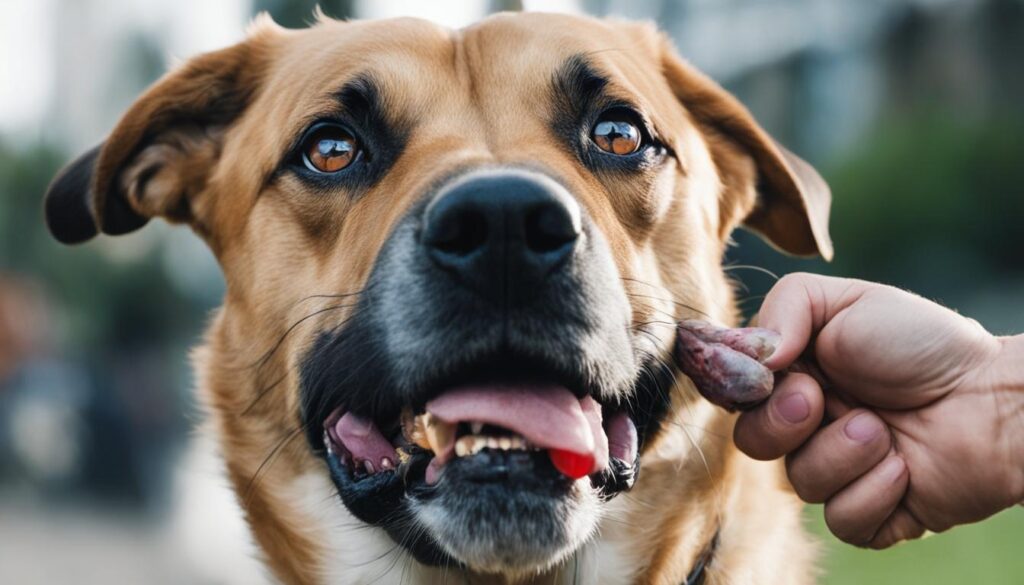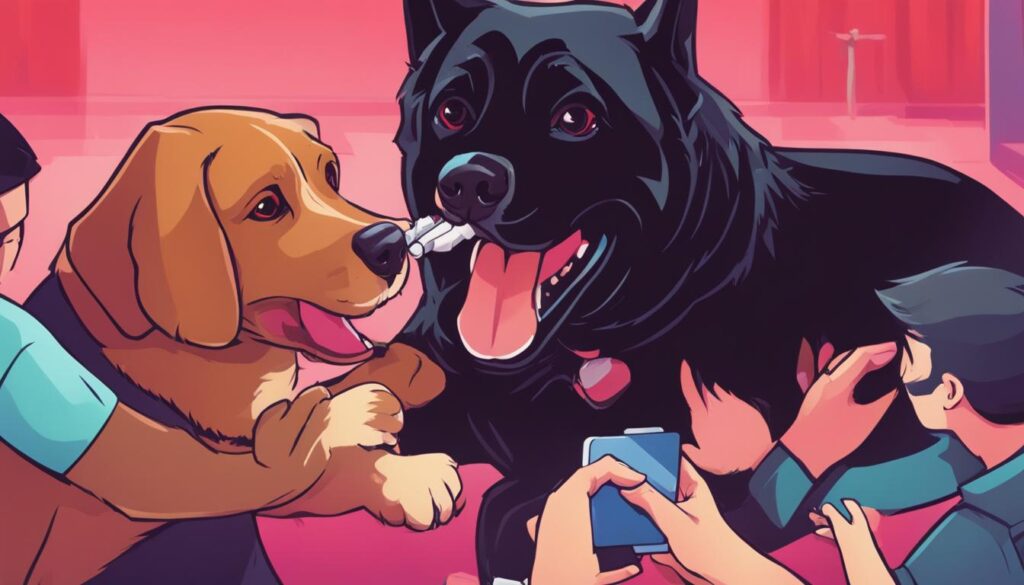As a dog owner, it’s crucial to be prepared for any emergency that may arise, including a choking incident. Dogs are curious creatures and can easily get themselves into situations where they choke on small objects or food. In such a critical moment, knowing how to assist a choking dog can make a lifesaving difference.
In this comprehensive emergency guide, I will provide you with the essential information and steps to help a choking dog. From recognizing the signs of a choking dog to understanding the proper procedures and preventive measures, you’ll be equipped with the knowledge and skills to act decisively in an emergency.
By gathering factual data from various sources and experts in the field, we aim to provide you with a comprehensive resource that covers everything you need to know about canine choking first aid and emergency dog choking assistance.
Key Takeaways:
- Recognize the signs of a choking dog, such as pawing at the mouth, gagging, coughing, and making choking sounds.
- Act promptly if your dog is choking by restraining them safely, conducting a mouth inspection, and attempting to remove the obstruction.
- Learn the Heimlich maneuver for dogs and how to perform it effectively for both small and large breeds.
- Know when to seek professional help if initial measures fail to dislodge the obstruction.
- Provide appropriate aftercare for a choking dog, including monitoring for injuries and seeking veterinary attention if necessary.
Signs of a Choking Dog

Identifying the signs of a choking dog is crucial for prompt intervention. When your furry friend is choking, they may exhibit the following symptoms:
- Pawing at the mouth
- Gagging and coughing
- Making choking sounds
If you notice your dog displaying these signs, it’s important to act quickly. However, it’s essential to differentiate choking from other causes of coughing or retching in dogs before taking any action.
“Quickly recognizing the signs of a choking dog can be life-saving. If your dog is pawing at their mouth, gagging, coughing, or making choking sounds, there’s a high possibility that they are choking.”
By being observant and responsive to these signs, you can promptly provide the necessary assistance to your choking dog.
| Signs of a Choking Dog | Action Needed |
|---|---|
| Pawing at the mouth | Immediately check the mouth and throat for any obstructions. |
| Gagging and coughing | Monitor the severity of the choking and assess if immediate intervention is required. |
| Making choking sounds | Stay calm and prepare to perform dog-specific first aid techniques. |
What to Do if Your Dog is Choking

In a choking emergency with your dog, taking immediate action can be critical to their safety. Here are the essential steps to follow:
- Stay calm: It’s important to remain calm to assess the situation and act quickly.
- Restrain your dog: Ensure your dog is safely restrained to prevent any accidental bites or injuries during the process.
- Check for breathing: Gently lift your dog’s lips and observe if there is any obstruction or sign of breathing difficulty. Be cautious not to get bitten during this inspection.
- Remove the obstruction if possible: If you can see and safely reach the obstruction, attempt to remove it. However, be careful not to push the object further down the airway.
- Perform the Heimlich maneuver: If the obstruction persists, you may need to perform the Heimlich maneuver. This technique involves applying pressure to the dog’s abdomen, just below the ribcage. Refer to Table 1 for detailed instructions.
- Seek veterinary assistance: If your dog is still choking after attempting the above steps, contact your veterinarian immediately. They can guide you through further actions and provide professional assistance.
Table 1: Heimlich Maneuver for Dogs
| Size of Dog | Procedure for Performing the Heimlich Maneuver |
|---|---|
| Small Dogs (less than 30 lbs) |
|
| Large Dogs (over 30 lbs) |
|
Prevention is key when it comes to dog choking incidents. To minimize the risk, ensure you provide a safe environment for your dog by:
- Keeping small objects that could be swallowed out of your dog’s reach.
- Choosing appropriate-sized toys and treats for your dog.
- Regularly inspecting and replacing worn-out or damaged toys.
- Supervising your dog during playtime, especially with new toys or objects.
By following these steps and prioritizing prevention, you can be better equipped to handle a choking emergency and protect the well-being of your beloved canine companion.
The Heimlich Maneuver for Dogs

The Heimlich maneuver is a valuable technique that can be used to assist a choking dog in certain situations. It involves applying abdominal thrusts to dislodge the obstruction and restore normal breathing. It is important to note that the Heimlich maneuver should only be performed on a conscious choking dog.
Performing the Heimlich Maneuver on Small Dogs
For small dogs weighing less than 30 pounds, follow these steps:
- Position yourself behind the dog and make a fist with one hand, placing it just below the ribcage.
- Wrap your other hand around your fist and apply upward pressure in quick, forceful movements.
- Repeat this motion up to 5 times, checking for any signs of improvement or the dislodgement of the object after each thrust.
- If the obstruction is not cleared, seek veterinary assistance immediately.
Performing the Heimlich Maneuver on Large Dogs
For large dogs weighing more than 30 pounds, follow these steps:
- Position yourself behind the dog and place your hands just below the ribcage, with one hand overlapping the other.
- Apply strong upward pressure towards the dog’s spine, using your body weight if necessary.
- Perform this maneuver up to 5 times, with brief breaks to assess the situation.
- If the object is still stuck, immediately contact your veterinarian for further guidance.
The Heimlich maneuver for dogs should only be used in cases of conscious choking, as it may cause further harm if performed incorrectly or on an unconscious dog. It is crucial to maintain a calm demeanor and seek professional help if the obstruction is not cleared.
Remember, every second counts when it comes to assisting a choking dog. Being prepared and having knowledge of life-saving techniques like the Heimlich maneuver can help you take swift and effective action in an emergency.
What to Do if Initial Measures Fail

If despite your best efforts, the initial measures to dislodge the obstruction from your choking dog are unsuccessful, it is crucial to know when to seek professional help. While it can be distressing to see your beloved pet continue to struggle, contacting a veterinarian is the next step in ensuring your dog’s well-being.
Veterinarians possess the knowledge, skills, and resources to handle complex choking cases and provide the necessary professional assistance. They are trained to assess your dog’s condition and determine the best course of action to alleviate the obstruction.
When faced with a choking dog, monitor their symptoms closely. If your dog’s condition worsens, they lose consciousness, or you notice any alarming changes in behavior, it is imperative to call the vet immediately. Time is of the essence, and prompt action can make a significant difference in the outcome.
If your dog is experiencing severe respiratory distress, turning blue, or unconscious, do not hesitate to seek emergency veterinary care. These signs indicate a life-threatening emergency that requires immediate intervention.
Remember, choking incidents can be unpredictable, and professional help may be necessary even after attempting initial measures. Trained veterinary professionals are equipped to handle emergency situations and provide the expertise needed to ensure your dog’s safety.
Seeking professional assistance for a choking dog not only increases the chances of successfully resolving the obstruction but also mitigates the risk of complications and potential harm to your furry companion. Always prioritize your dog’s well-being and act swiftly to secure the necessary professional help.
Next, let’s explore the essential aftercare steps for a choking dog to support their recovery and prevent future incidents.
Choking Dog Emergency Steps
| Step | Description |
|---|---|
| Attempt initial measures | Perform the Heimlich maneuver, check the mouth for visible obstructions, and use gravity to help dislodge the object. |
| Monitor the dog’s symptoms | Observe for signs of improvement or worsening, paying close attention to breathing difficulties or loss of consciousness. |
| Contact a veterinarian | If initial measures fail or the dog’s condition deteriorates, call the vet for professional guidance and assistance. |
| Seek emergency care if necessary | If your dog shows severe respiratory distress, turns blue, or loses consciousness, seek immediate emergency veterinary care. |
Aftercare for a Choking Dog

Once you have successfully addressed a choking incident in your dog, it is crucial to provide proper aftercare to ensure their recovery. Paying close attention to your dog’s throat and mouth is essential, as these areas may have sustained injuries during the choking episode. Keep an eye out for any signs of discomfort or swelling, such as difficulty swallowing, excessive drooling, or changes in appetite.
If you notice any concerning symptoms, it is advisable to seek veterinary attention promptly. A professional evaluation can help identify and address any underlying issues, ensuring your dog receives the necessary treatment for a speedy recovery.
During the post-choking stage, it may be necessary to adjust your dog’s diet temporarily. Opt for soft and easily digestible foods to minimize any potential discomfort or further irritation to the affected areas. Make sure to provide plenty of fresh water as well, as it can help soothe your dog’s throat.
Remember, every dog is unique, and their recovery process may vary. It is crucial to closely monitor your dog’s condition and progress throughout their recovery journey. If you have any concerns or uncertainties, do not hesitate to consult with your veterinarian for guidance and support.
Aftercare Checklist for a Choking Dog:
- Monitor for signs of throat or mouth injuries
- Observe for discomfort, difficulty swallowing, or changes in appetite
- Seek veterinary attention if necessary
- Provide a soft diet to minimize discomfort
- Ensure access to fresh water for soothing the throat
- Monitor progress and consult with your veterinarian if needed
By following these aftercare guidelines, you can help facilitate your dog’s recovery after a choking incident. Taking the necessary steps to provide appropriate care and seeking professional assistance when needed will contribute to your dog’s overall well-being.
| Common Aftercare Measures for a Choking Dog | Benefits |
|---|---|
| Monitoring for throat and mouth injuries | Early detection and prompt treatment of any injuries |
| Soft diet | Minimizes discomfort and irritation to the affected areas |
| Access to fresh water | Soothes the throat and helps with hydration |
| Seeking veterinary attention if necessary | Professional evaluation and treatment for underlying issues |
Choking Hazards for Dogs

Dogs are curious creatures that can encounter various choking hazards in their environment. It’s essential for dog owners to be aware of common objects that dogs may choke on and take preventive measures to ensure their safety. Here are some important tips to prevent choking accidents in dogs and promote dog toy safety:
Common Objects That Dogs Choke On:
- Small toys or toy parts
- Bones
- Sticks
- Rocks
- Coins
- Jewelry
- Household items (e.g., buttons, batteries, rubber bands)
Preventing Choking Accidents in Dogs:
- Supervise your dog during playtime to prevent them from swallowing inappropriate objects.
- Avoid giving your dog small toys or toys with detachable parts that can be easily swallowed.
- Provide appropriate-sized toys that are specifically designed for dogs.
- Choose toys made from safe materials that won’t easily break or crumble.
- Regularly inspect your dog’s toys for signs of wear and tear, and replace them if necessary.
- Avoid giving your dog bones or other hard objects that can splinter and pose a choking hazard.
- Keep small household items out of your dog’s reach to prevent accidental ingestion.
By being proactive and following these tips, you can significantly reduce the risk of choking accidents in dogs. Remember, your dog’s safety should always be a top priority, and choosing safe toys and monitoring their playtime can help keep them out of harm’s way.
Emergency Resources and Training
Being prepared for emergencies is crucial for dog owners. In addition to knowing how to respond in a choking emergency, it’s beneficial to access valuable resources for further training and education. These resources can enhance your ability to provide immediate assistance and potentially save your dog’s life.
Dog First Aid Course
In-depth knowledge of basic first aid techniques specific to dogs is invaluable in emergency situations. Enrolling in a dog first aid course can equip you with the necessary skills to handle various emergencies, including choking incidents. These courses typically cover topics such as wound care, CPR, and choking response protocols.
Online Dog First Aid Training
If attending a physical class is challenging, online dog first aid training provides a convenient alternative. These virtual courses offer comprehensive instructional materials, videos, and interactive modules that allow you to learn at your own pace. You can access vital information on choking emergencies and other life-saving techniques from the comfort of your home.
Dog CPR Techniques
In addition to canine first aid, learning dog CPR (cardiopulmonary resuscitation) techniques is essential. CPR can be a critical intervention in a choking emergency when the obstruction cannot be promptly dislodged. Numerous resources, including instructional videos and step-by-step guides, are available to guide you through the process of performing CPR on dogs.
Instructional Videos
Visual demonstrations can significantly enhance your understanding of proper choking response techniques. Dog choking videos provide real-life examples, demonstrating various approaches to dislodge an obstruction. These videos typically showcase the Heimlich maneuver and other techniques, allowing you to observe and familiarize yourself with the proper execution.
Dog First Aid Resources
There are numerous dog first aid resources available, including books, articles, and online references. These resources provide detailed information on recognizing emergencies, administering first aid, and preventing accidents. They serve as comprehensive references for dog owners seeking to enhance their emergency preparedness and response capabilities.
By taking advantage of these emergency resources and training, you can develop the necessary skills and knowledge to respond effectively in a choking emergency. Preparedness is key to ensuring the safety and well-being of your canine companion.
The Importance of Prompt Action
When a dog is choking, prompt action is of utmost importance. Acting quickly can prevent further complications and potential harm to the dog. As a responsible dog owner, it is crucial to be prepared and knowledgeable about the steps to take in a choking emergency.
Every second counts when a dog’s airway is obstructed. Quick response can potentially save the dog’s life and minimize the risk of long-term consequences. Without timely intervention, the lack of oxygen can lead to severe brain damage or even death.
“The key to helping a choking dog is taking immediate action. Don’t hesitate or waste time searching for solutions. Start assessing the situation and performing the necessary procedures to clear the airway as soon as possible,” says Dr. Sarah Thompson, a renowned veterinarian.
To ensure a quick response, it is essential to familiarize yourself with the signs of a choking dog, as discussed in Section 2. By recognizing these signs, you can initiate immediate action and increase the chances of successful intervention.
In emergencies, time is a critical factor. Being prepared and equipped with the knowledge on how to help a choking dog can make all the difference. Practice the Heimlich maneuver for dogs and other first aid techniques in advance to build confidence and enhance your ability to act decisively.
Remember, prevention is always better than cure. By following the choking prevention tips outlined in Section 10, you can significantly reduce the risk of your dog choking on hazardous objects.
In summary, the importance of prompt action for a choking dog cannot be overstated. Acting quickly, being prepared, and having the right knowledge can save your dog’s life in a choking emergency.
Choking Prevention Tips for Dogs
Taking preventive measures is crucial to reducing the risk of choking incidents in dogs. By implementing the following tips and recommendations, you can create a safer environment for your furry friend and minimize the chances of choking accidents.
Toys
When selecting toys for your dog, keep their safety in mind. Opt for toys that are specifically designed for dogs and are free from small parts or easily broken pieces. Avoid toys with strings, small bells, or detachable parts that could potentially be swallowed and cause choking hazards. It is also essential to regularly inspect toys for signs of wear and tear and replace them when necessary.
Treats
Choose safe and appropriate treats for your dog to minimize the risk of choking. Opt for treats that are specifically made for dogs and are the appropriate size for your dog’s breed and age. Avoid giving hard, brittle treats that can easily splinter and pose a choking hazard. It is always a good idea to supervise your dog while they enjoy their treats.
Feeding Environment
Create a calm and safe feeding environment for your dog. Ensure that your dog eats in a quiet area where they won’t be distracted or feel rushed. Avoid feeding your dog in crowded areas or near other pets to prevent accidental ingestion of foreign objects or competition-induced eating behavior that can lead to choking.
Training
Proper training can significantly contribute to preventing choking accidents. Teach your dog basic commands such as “drop it” or “leave it” to discourage them from picking up and swallowing potentially dangerous objects. Training your dog to eat slowly can also help prevent choking, especially for those who tend to gulp their food quickly. Consider consulting a professional dog trainer for guidance on effective training techniques.
Supervision
Never leave your dog unattended while they are chewing on toys, bones, or other items. Regularly check on your dog and ensure they are not showing signs of choking or distress. Immediate intervention can be lifesaving when it comes to choking incidents.
Other Household Hazards
In addition to toys and treats, be mindful of other potential choking hazards in your home. Keep small objects, including coins, buttons, and jewelry, out of your dog’s reach. Secure electrical cords and cables that your dog may be tempted to chew on. It is also advisable to keep garbage cans securely closed to prevent your dog from scavenging potentially hazardous materials.
Summary
Preventing choking accidents in dogs requires proactive measures and responsible ownership. By selecting safe toys, choosing appropriate treats, creating a safe feeding environment, providing proper training, supervising your dog, and recognizing and eliminating household hazards, you can reduce the risk of choking incidents and help ensure your dog’s well-being.
Dog Choking vs. Other Respiratory Issues
When it comes to a dog experiencing respiratory distress, it’s essential to differentiate between choking and other breathing problems. While both situations can be concerning, the appropriate intervention may vary depending on the underlying issue.
Choking in dogs occurs when an object obstructs their airway, impeding their ability to breathe properly. Common signs of dog choking include pawing at the mouth, gagging, coughing, and making choking sounds. Immediate action is required to remove the obstruction and restore normal breathing.
On the other hand, respiratory issues unrelated to choking can stem from various causes such as allergies, infections, or underlying health conditions. Unlike choking incidents, these problems generally do not involve an obstructed airway. Instead, dogs may exhibit symptoms such as wheezing, difficulty breathing, rapid breathing, or nasal discharge. It’s crucial to stay vigilant and consult a veterinarian for a proper diagnosis in such cases.
To effectively differentiate between choking and other respiratory issues, careful observation of the dog’s symptoms is necessary. If there is clear evidence of an object blocking the airway, prompt action is crucial. However, if the dog’s breathing difficulties appear persistent, unrelated to an obstruction, or accompanied by other concerning symptoms, it’s important to seek professional veterinary assistance.
Understanding the distinction between choking and other respiratory problems is vital for dog owners. It ensures appropriate action is taken to address the specific issue at hand, preventing further complications and promoting the well-being of our beloved four-legged companions.
| Choking | Other Respiratory Issues |
|---|---|
| Obstructed airway due to an object | Causes unrelated to choking |
| Pawing at the mouth | Wheezing or difficulty breathing |
| Gagging and coughing | Rapid breathing or nasal discharge |
| Immediate intervention required | Veterinary consultation recommended |
Wrapping Up
In conclusion, this comprehensive dog choking emergency guide provides essential information to equip dog owners with the necessary knowledge and skills to act swiftly in a choking emergency. By understanding the signs of a choking dog, the proper procedures to perform, and the preventive measures to take, you can become a confident and capable responder. Remember, prioritizing the safety and well-being of your furry companion is paramount.
By following the steps outlined in this guide, including restraining the dog safely, conducting a mouth inspection, and attempting to remove the obstruction if possible, you have a greater chance of successfully assisting a choking dog and potentially saving their life. Additionally, knowing when to seek professional help and providing appropriate aftercare are vital components to ensure a dog’s recovery and well-being.
To prevent choking accidents, it’s crucial to be aware of common choking hazards, such as small objects and unsafe toys. By selecting safe toys and treats, creating a safe environment, and monitoring your dog’s playtime, you can significantly reduce the risk of choking incidents. It’s also recommended to familiarize yourself with dog first aid resources, such as training courses and instructional videos, to enhance your emergency response skills.
Remember, your quick and decisive action can make all the difference in a choking emergency. By staying informed, prepared, and proactive, you can be a reliable source of aid for your beloved furry companion.
FAQ
What are the signs of a choking dog?
The signs of a choking dog include pawing at the mouth, gagging, coughing, and making choking sounds.
What should I do if my dog is choking?
If your dog is choking, you should safely restrain the dog, conduct a mouth inspection, and remove the obstruction if possible. It’s important to act quickly and calmly.
How do I perform the Heimlich maneuver on a choking dog?
To perform the Heimlich maneuver on a choking dog, follow the proper technique for small or large breeds. This involves applying upward pressure on the abdomen to dislodge the obstruction.
What should I do if initial measures to dislodge the obstruction fail?
If initial measures fail to dislodge the obstruction, it’s important to seek professional help. Contact your veterinarian or an emergency clinic for further assistance.
What should I do after my dog chokes?
After your dog chokes, monitor for any signs of injury to the throat or mouth. Provide a soft diet if there is discomfort, and seek veterinary attention if necessary.
What are common choking hazards for dogs?
Common choking hazards for dogs include small toys, bones, strings, and pieces of food that are not suitable for chewing. It’s important to be aware of these hazards and create a safe environment for your dog.
Are there any resources available for dog first aid and choking emergencies?
Yes, there are various resources available, including dog first aid courses, online training, CPR techniques, instructional videos, and other educational materials. These resources can enhance your ability to respond effectively in emergency situations.
Why is prompt action important when a dog is choking?
Prompt action is important when a dog is choking to prevent further complications and potential harm to the dog. Immediate intervention can often save a dog’s life.
How can I prevent choking accidents in my dog?
To prevent choking accidents in your dog, choose safe toys, avoid giving them small objects or bones, supervise playtime, and ensure appropriate treat selection. Creating a safe environment is crucial for preventing choking incidents.
How can I differentiate choking from other respiratory issues in my dog?
Differentiating choking from other respiratory issues in dogs involves recognizing the signs and assessing the circumstances. Choking is characterized by a sudden onset and can be resolved with immediate intervention, while other respiratory problems may have different symptoms and require alternative treatments.






